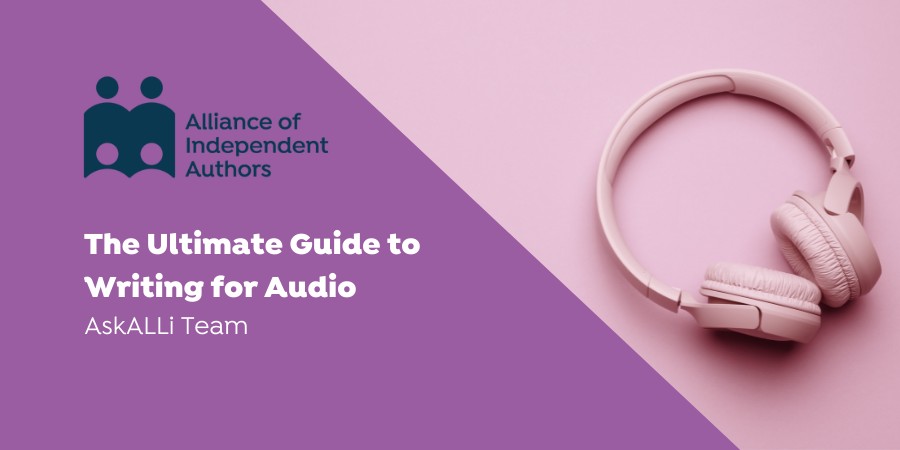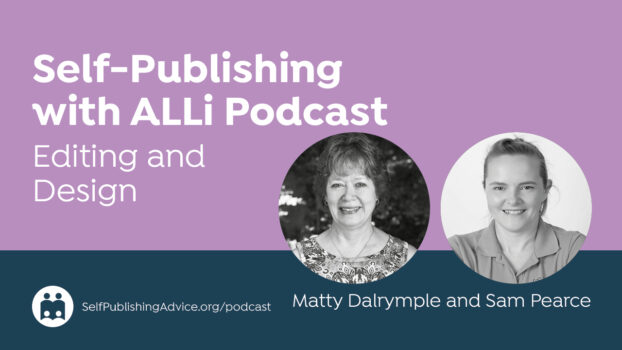Audiobooks are big business. But what exactly does “writing for audio” mean? And how do you do it? Today, the Alliance of Independent Authors welcomes author member, Jules Horne, and partner member Pozotron, to discuss exactly that. This is the ultimate guide to writing for audio.

Jules Horne
Writing for Audio: An Author Perspective
Jules Horne is a writer and indie publisher from the Scottish Borders. Her creative writing includes fiction, plays for stage and BBC radio, experimental film and spoken word. She has a background in journalism and copywriting, and has designed writer training for the Open University. Visit her website here, or find out more about her on Facebook and Instagram.
With thanks to Jules, for the excerpt from her book Writing for Audiobooks: Audio-First for Flow and Impact.
Writing for Audio is Different!
If you’ve ever written for radio, the stage or performed your poetry, you’ll know that writing for audio is different. Radio writing is tighter, crisper, more economical – you don’t have the same expansive freedoms as in fiction. And you need to leave room to breathe. Many fiction writers don’t realise that when they get into audio, they’re becoming a radio writer. A scriptwriter! And they need to learn some craft techniques, if they’re going to make the most of their huge investment in audio production.
A manuscript edited with audio in mind will really sparkle and stand out. And it’s not just about character dialogue, though cracking dialogue really helps. It’s also about your general prose – its rhythms, economy, energy, and whether it’s easy to perform. Yes! Audio writing is writing for performance. And with some simple tweaks, your narrator will be overjoyed at your tight, clear sentences, your lovely landing phrases, signposting, “radio pictures” – in short, the craft skills of writing for the ear.
Below is an excerpt from my writing guide, “Writing for Audiobooks”, which includes lots of pro tips from radio writing. You can also get 3 free tipsheets and an email mini-course on audio-first writing by joining my mailing list at method-writing.com.
Signposts and Order of Information
How you unfold information in audio has a big impact on comprehension. You can listen to Jules’ ALLi interview on ‘attunement’ with Howard Lovy here:
To avoid mental backflips in audio, set the larger context first, and then give the details:
Deep in the woods, the owl flitted across to the oak tree, a mousetail dangling from its beak.
Rather than:
A mousetail dangled from the owl’s beak as it flitted across to the oak tree deep in the woods.
By the time we’ve got to the end of that sentence, we’ve forgotten how the parts connect, as we’re not given the context first, to slot things into. “Context, then detail” is easier for the brain to work with than the other way round.
Similarly, in radio writing, the convention is to say:
The UK Foreign Minister, Susie Shepherd…
rather than:
Susie Shepherd, the UK Foreign Minister…
because the political role and context are more important than the individual’s name. Imagine the phrase with a name you’ve never heard of, and you’ll see the point.
The child actor, Tina Small…
rather than:
Tina Small, the child actor.
and
The shipping magnate Buster Walker…
rather than:
Buster Walker, the shipping magnate.
If you’re writing fiction, try setting the scene first, and then drawing the listener’s viewpoint closer into the story:
The sun was setting over Istanbul as the muezzin began his mournful singing.
Sentence Length
As you’ve gathered, sentence length in audio needs to be relatively short. That’s so that sentences can be performed clearly, and with effective flow. Sentences which are so very long and convoluted and without any spaces in between them that they can’t be read out successfully without an extra breath are a bad idea.
Seriously, any sentence that is more than three lines long and has you collapsing red-faced in a corner at the end needs to be cut in two, or severely pruned. Your narrator will thank you.
“Which”, Brackets, Dashes
A particular culprit in overlong sentences is the word “which”. Long phrases with which, brackets or dashes are often used to qualify or explain something else. For example:
The DOG – which she’d rescued from the cat and dog home and installed in her flat – HAD a rough, tangled coat.
Whether you punctuate this with brackets, dashes, or commas, the effect is the same: The qualifier phrase separates the noun and its related verb. With the verb and noun so far apart, it’s true you’re creating an arc of attention. But if you stretch it too far, the connection can break.
For example:
The knife, which she stole from the kitchen and which had a worn wooden handle and sharp shiny blade that stuck through the bottom of her soft suede handbag, was heavy.
Not only do you need very good lungs to read aloud which clauses like this, it’s also likely the reader will have forgotten what you were talking about, by the time you get to the end. So do your listener a favour and cut which clauses right down. It’s often better to rewrite an aside like this, and break it into two or more sentences.
Tenses
The past perfect tense – she had been down in the basement – can sometimes cause mental backflips.
For example:
He had been down in the kitchen when he heard her rummaging around in the drawer. She had retrieved the knife and put it in her bag before going upstairs.
Here’s another:
Although she’d already retrieved the knife before heading up the stairs…
Woah! What happened when and where? In what order did the events unfold? Overuse of subordinate clauses can make people’s heads go into a mental tailspin. It’s often better to use the simple past, or sometimes the present tense, and unfold events in a linear way:
She went to the drawer and retrieved the knife. Then she headed up the stairs.
Endings
Along with openings, endings are a key “power position”. An ending gives the final impression that resonates with audiences. If they’re at a performance such as a stage show, it’s the impression they go home with into the night. So, endings have disproportionate impact. They need to be strong, clear and resonant.
Of course, this is true for books and stories, too. You’ll want to complete a satisfying arc for your readers, with rising tension, a climax and a falling, resonant moment at the end. But flow operates at different scales. So endings are powerful not just in complete works, but also in paragraphs and sentences.
Landing
The end of a sentence or paragraph is a breathing space. There’s a moment of silence, which creates contrast with the flow of words. Intonation falls to a point of rest. In other words, the sentence lands.
“Landing” is a really useful concept for writers. I’ve often heard it used by directors in rehearsal. They might, for example, tell an actor, “that line isn’t landing”. In other words, it isn’t hitting home clearly, so that it’s properly heard, and has full impact.
We’ve already heard that nouns are important in performance, and need to land properly. Well, endings are a powerful position for words that need to stand out – for example, the three key elements discussed earlier. Some words are more important than others for the meaning of your story.
But often, I see writing where key elements are buried in a chunk of prose, and almost invisible. For example:
She walked up the stairs carrying a knife in her left-hand pocket, clinging tight to the banister as she reached the third floor and saw the lamplight shining under the crack in the door.
It’s possible you didn’t even notice the knife in that paragraph. Or that you’d forgotten it by the time I reached the end. And yet it’s the murder weapon. To make the word “knife” land effectively, and have full impact on listeners, it needs to stand out. It can’t compete for attention with everything else in the paragraph.
Skilled writers shape their writing around key elements which they want to be salient. They make sure they aren’t buried by a clutter of words, and use emphatic positioning to create a powerful sense of music. So, for example, you might revise that sentence to say:
She climbed the stairs slowly, clinging tight to the banister, her hand deep in her pocket, clutching the rusty carving knife.
In this example, the knife lands at the end of the sentence – a prominent position that gets more attention than the middle. Some of the adjectives have also been cut so that they don’t distract – like cutting away weeds. You could also put the knife in the first sentence, at the end to allow for attunement.
Her small suede shoulder bag wasn’t made to carry knives.
And then, you could use “touches” to develop each key element, and create a more vivid picture. In this instance, there’s a knife, a bag and some stairs.
Her small suede shoulder bag wasn’t made to carry knives. Certainly not long steel Japanese fish knives. The wooden handle stuck out three inches, and the sharp point pierced through the soft leather. It would have to do. She clutched the bag and its awkward cargo to her side, and began to climb the stairs.
Recalling the stairs at the end reinforces the picture effectively, because it shows the character in her context. Note that poets also use the power of line endings. They can choose to land with the line ending – a so-called “end-stopped line”. Or disrupt the line ending – also called a “run-on” line – which helps to sustain flow.
Poets go further and distinguish between masculine and feminine line endings. With masculine endings, the line ends in a stressed syllable – for example, the word “knives” or “de-SPAIR”. With feminine endings, the line ends in an unstressed syllable – for example, the word “LET-ter” or “LAND-ing”. Masculine endings sound more abrupt, while feminine endings sound softer and reverberant. Use this to vary the rhythmic effect at the ends of sentences.
Note that although emphatic landing is a useful technique, anything that’s overused can become repetitive. It’s best to use different techniques and vary your rhythms – disrupt the pattern, in other words. Ever-changing ebb and flow keeps things interesting.
***
Want to learn more about writing for the ear? See Jules’ book Writing for Audiobooks, and join her mailing list at method-writing.com to get 3 free tipsheets and an email mini-course on audio-first writing.
Writing for Audio – Bridging the Gap Between the Written and Spoken, for Authors
Ryan Hicks has been in the audiobook industry since 2013, moving into his current position at Pozotron in 2020. His educational background is in journalism and recording engineering. He loves telling stories and hearing other people tell theirs in all the creative ways possible. Find out more about him on their website or Instagram.

Ryan Hicks, Director of Outreach, Pozotron Inc.
Set the Scene
As an author, can you imagine holding your book in your hands? It’s the hardcover version. The title is big and bold. You’re outside on a windswept plain. Facing east, the sun is dropping behind you. There’s a fire pit in front of you, glowing embers, small controlled flames, and a single person seated on the other side, comfortable in a chair, sunglasses to temper the glare of dusk.
You speak the name of the book, and then the phrase ‘written by me, the author.’
It’s been months or years since you started production of the book, and the ideas themselves could be from so long ago you don’t even remember where the seeds of your plots and characters came from. But this is your creative child. And now you’re here, and you have an audience of one, and you’re going to read out loud.
What happens next is an unwelcome buzz to your system. The chapter title sounds fine, and your initial descriptions and the energy flowing into the story, the introduction into your world—they start pretty well. And then there’s a hitch in the giddyup. You realize that you’ve never actually performed your book like this, never spoken the words aloud in sequence, in the context of an in-person audience, and by the second page, the thought in the middle of your brain is, ‘oh dear.’
Some words are hard to say. Some sentences feel awkward coming out of your mouth, the way the vowels and consonants wrestle with each other. Your listener is trying to follow the story. They can’t go back and re-read, so the only thing they have is the sentence you are currently performing, and whatever memory they may have of what happened to get to here.
Your book is a full novel. You’ll be talking for 10 hours. Straight. Maybe with a pause for a shot of whiskey when all is lost during the hero’s journey.
As you read, there’s a consistent reflection in the back of your mind – ‘ah, this doesn’t sound like I thought it would.’ Or sometimes more specifically ‘ah, people don’t really talk like this, do they?’. Or another. ‘Ah, I didn’t mean it that way.’ Or. ‘This is getting a little complicated, isn’t it.’
You remember all the warnings – “dialogue is really, really hard to write well.” And you recall the time spent editing, when you chose to ignore comments about sentence length or structure because you liked how the words looked on paper.
You’re face to face with this moment, and you realize that you didn’t think deeply outside of the printed word—you didn’t write for the words to be spoken.
The Self-Check
You don’t have to be a professional narrator or an actor to check that your book is audio-friendly. Here are some tips to check on the relationship between your written and spoken words.
- Realize above all that reading in your head is not the same as reading out loud. They are completely different animals.
- Turn on a video camera and get a reasonable microphone, and record yourself performing a chapter of your book. Watch it back and listen for flow. Look at the expressions on your face while you’re reading.
- Have someone else read a chapter of your book out loud to you. Watch and listen to what happens. Are they getting the emotions right the first time through, or do they have to go back when they find out the necessary descriptions for a scene come after the next sentences have wandered by?
- Say the phrase ‘she grasps the clasp of the hasp, and the uncommunicative administrator inside shrugged her soldier’s shoulders’. Authors can add alliterative, multisyllabic monsters for fun and because it can look like artwork on the page, but it can be impossible to narrate well.
There’s a famous story that gets passed around among narrators as well, that’s supposed to illustrate some of the adversarial relationship between authors and narrators. It’s about the use of the phrase ‘pocketed it.’
Eyes to the Future
It may be that your novel never comes out with an audiobook version. But there are several key benefits to you as an author if you approach it as though it might.
- You start thinking about engaging a different audience earlier in your marketing planning.
- You start researching audiobook production costs, returns on investment, and schedules as you’re writing your original manuscript.
- You pay closer attention to natural dialogue as brought out into the physical world.
- Your writing and storytelling may improve a lot with additional attention to vocal potential
- Your writing won’t get any worse by considering the narrative value of your book
Using Technology To Help You Be a Better Author for Narrators
As an author who wants the best for their book, you use all the tools at your disposal.
- Your choice of word processor matters for efficiency, consistency, and analysis.
- If you use something like Grammarly or Prowritingaid, you can really tighten down stylistic and contextual elements as well as do basic grammar and structure checks. This matters to narrators.
- Look at transcription software that can help you dictate parts of your book
- Explore narrative accuracy checking software like Pozotron, to help you ensure your audiobook is read as you intended it, accurate to your text and with correct pronunciations and character voices.
Summary
I’ve been editing and proofing audiobooks professionally since 2013, the majority of that time as an independent contractor with Deyan audio. Having listened to many hundreds of books from brand new narrators all the way through the most seasoned pros, a consistent thought has always been that I wished authors would consider vocalization and narrative flow more in their writing.
Every single book that I’ve ever worked on could have been better with an editing pass through the lens of a narrator.
I worked on one celebrity project where the author came into the studio and made a big deal about creating an audio version of the book. Not two minutes into the session, they sounded shocked.
“Oh wow. I’ve never actually said these words out loud before.”
I’m particularly passionate about illustrating the gap between what is and what could be when it comes to writing for audio. With just a subtle reframing of intention from the very beginning of the book writing process, the potential for an improvement in textual as well as auditory aspects of storytelling is massive.
If you’re currently writing a book, working through the process of crafting your story in text, consider some of the suggestions here and see how quickly your ah-ha moments will bubble to the surface.
You can also reach out to me to brainstorm how to ensure your book is ready for audio by emailing me at [email protected]. I look forward to chatting with you!





I was looking to find some blogs on writing for audio to get some help to know how can we easily write for audio. I got to learn a lot of things from here and a lot more to learn for me I got some thoughts clear after reading this and I hope I will find more like this and then I can start writing for audio.